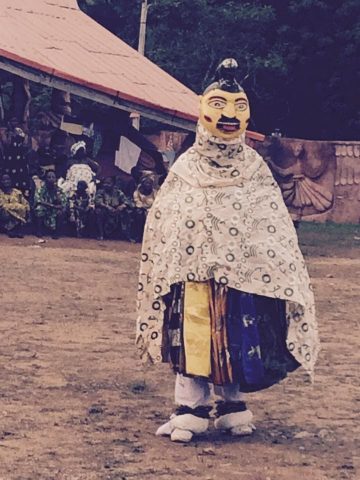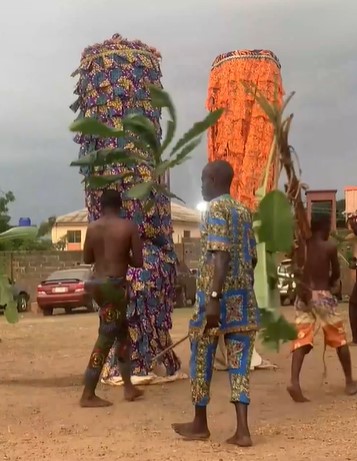One day a man came for the Ifá divination with the aim of finding out what to do in order to improve his life. He was advised to make an offering to his ancestors so that they shall look upon him through blessed eyes. He did what he was told and received a blessing from his ancestors.
Ancestor worship is one of the best prescriptions you can give to anyone because with the help of the ancestors, one is able to find solutions to all problems.
The connection to our ancestors is so intimate that in the Yoruba tradition, the deceased are buried at home and not at a cemetery. This way they can wish their ancestors good morning and good night every single day. They can sit on their ancestors’ grave crying or laughing as death does not separate us from life, it is merely a passage into another plane of existence.
Therefore, if we love someone, we say ó dàbọ̀ – which means “see you soon”. The reunion may occur in dreams, in our imagination, through a feeling that we have lost someone we loved, or simply as a result of worshiping our ancestors.
For us death does not mark an end to anything. Death is just a new beginning, a possibility to be born again. In regards to ancestry, there are two kinds of forebears: the female and the male ones.
The first thing we have to understand is the concept of death.
In Yoruba culture, death is called ikú. The word kú means “to die”. Death is the process of moving from one world into another.
If we do not acknowledge the existence of death, it is impossible for us to be liberated from its imminent danger. This brings us to the most interesting point: in the African world, death is celebrated, not bemoaned, meaning that people accept the reality of life. Death is comprehended in one of two ways: on the one hand, there is socially acceptable death of those who die at a later stage in life, and on the other, there is socially unacceptable death that refers to the tragic, unexpected deaths of young people. Such deaths are unexpected primarily because they occur at a young age, and in most cases, they are related to the energy called Àbíkú – born for premature death. This leads us to another reason why we worship our ancestors – to avoid the possibility of dying prematurely before living out our fate in full.
There are also two levels of ancestors, regardless of whether they are Egúngún (male ancestors) or Gẹ̀lẹ̀dẹ̀ (female ancestors): honourable ancestors and non-honourable ancestors.
Not everyone who dies is suitable to be regarded as a venerable ancestor. In order to be worshiped after death, one must achieve a certain level of existence while being alive. A person who rises up to a certain level of evolution during lifetime loses all family ties upon death and is generally worshiped as a venerable ancestor. Such people represent the doorway between the world of the living and the world of the dead.
This means that the behaviour and manners we exhibit over the course of our lifetime determine how we are going to be venerated after death. Once a venerable person dies, an invocation is made, and his or her energy then materializes so it can become the messenger for all people.
Our character is what determines how we are going to be socially accepted while alive as well as after we die. Your opportunity to ensure a good reincarnation and positive evolution starts now, at this very moment.
Ancestors symbolize community, construction, and development. They are the symbol of peace and harmony.
We invoke them to understand our direction in life and to urge them to fight for us and our interests.
Furthermore, we invoke our ancestors to ask them to give us orientation, to direct us to the right path, and show us the easiest way to overcome our problems.
Both male and female ancestors are represented by and manifested through a ritualistic costume used by a priest or a priestess as a medium.
For starters, it is enough to simply make a pledge to our ancestors and ask them for our well-being in our own language in any way we like.
However, if we want to radically change our life, we have to visit a priest or a priestess who is initiated into this energy.
Ancestor worship is especially important if we notice that the history is repeating itself and the same disease or the same habits run in the family. With ancestor worship we can erase the problems of past generations and prevent them from passing on to the future ones.
The energy associated with ancestor worship is too spiritual to be classified simply as part of religion.
There are two ways of worshiping ones’ ancestors; two ways of how to invoke the blessing of our forebears:
– we can make an offering – the best way to do that is to give them what they liked the most while still alive;
– we can prepare dinner at home for a group of people and dedicate it to a deceased ancestor – this is referred to as sàrafor the ancestors.
Another basic way of worshiping our ancestors is to clean their graves and light candles for them. Paying regular visits to the graves and talking to ones’ ancestors is greatly important, and verbal communication is particularly significant.
We distinguish between the physical-biological genetics on the one hand and astral, spiritual genetics on the other. At birth, a child brings into this world the physical-biological genetics of its family. Deceased ancestors have a strong impact on the astral-spiritual genetic line of the living.
We also worship the ancestors in order to be more harmonious and eliminate any turbulences in our lives. We are constantly in touch with the ancestors because we believe that the present is the continuation of our past and that the present moment is just a precursor to the future.
It doesn’t matter if we don’t know where our ancestors are buried. The spiritual, astral, physical, and biological genetics are stored in our bodies, accompanying us wherever we are. Therefore, we can always pray for our ancestors in our own way. A prayer is the expression of our wishes, of the things we want them to do. We can ask them for progress, health, money, good luck, etc. For this reason, we always say the following while addressing them: “You are the ones who said my life is going to be sweet, bring the sweetness of this planet into my life.”
Sometimes we advise our clients to go to the church they belong to and to pray for their ancestors there. The only thing that is forbidden in ancestor worship is to do nothing; not remembering them, not asking them for anything.

The expressions Egúngún, Egún, and bàbá-Égún refer to ancestors who are already gone, the inhabitants of ọ̀run that reveal themselves in ayé. The worshiping of the Egúngún energies takes a central role within the cults dedicated to male ancestors.
The ancestors who already took their path to ọ̀run remain by the side of their descendants at all times and have a crucial impact on all aspects of their lives, including their professional and family relationships. They can soothe the spirit, settle arguments, encourage solidarity, promote the spirit of unity and harmony, and renew our eagerness to work. Over and over again, they intervene in situations when a family is faced with a threat of falling apart due to conflicts or problems regarding inheritance. The word of Egúngún is always accepted and respected.
The purpose of the Egúngún cult is, among others, to repair the effects of the spiritual DNA that reflect in imbalances of all kinds – physical, emotional, and spiritual. All human beings receive biological, emotional, and spiritual heritage or genetic-spiritual-emotional burden from their ancestors. The Egúngún cult enables a retroactive operation. It works through destroying negative factors that accumulate over seven generations and are felt by a certain individual as various kinds of trouble, distress, illnesses, and other problems. The cult enables the resolution of family conflicts that include individuals from preceding generations, all with the purpose of repairing the resulting imbalances.
The symbols of Egúngún are: òta (an altar stone), ìrùkẹ̀rẹ̀ (an animal tail with artistic decoration that is infused with magic and worn by priests and priestesses, kings and queens as a sign of their royal dignity), àtòrì (a holy stick), ẹdan(male and female figures made out of metal), cowries, and wooden statues with seven carved headsthat symbolize seven generations. Their clothes and necklaces are multi-coloured.

Ẹgbẹ́ Gẹ̀lẹ̀dẹ́ is a community that includes both men and women and promotes fertility of all kinds, renovation of social behavioural rules, and attraction of Àṣé. The community is led by erelú, women who possess secrets and powers of the Mothers Ọṣòròngà. Gẹ̀lẹ̀dẹ́ is addressed as ìyá – mother, and as Igi because their ritualistic masks are carved out of a sacred tree with the same name.
The festival devoted to Gẹ̀lẹ̀dẹ́ is celebrated during the yam harvesting season and lasts for at least seven days. The participants gather in a procession and take to the streets where they accompany Gẹ̀lẹ̀dẹ́ all day long. Gẹ̀lẹ̀dẹ́ is embodied by men, but only after the dusk falls. They sing diverse liturgical songs that include ẹ̀fẹ̀. Ẹ̀fẹ̀ are liturgical songs with a humorous tone that publicly announce cases of unsuitable behaviour and actions by men, women, and children within the community that happened over the course of the previous year between the two festivals. The role of these liturgical songs is, among others, to have a regulative effect because they promote the rules of behaviour as well as the ethical and moral order that is always under the influence of female ancestral power.
During the Gẹ̀lẹ̀dẹ́ festival, certain symbols are especially highlighted, including large masks symbolizing animals and clothes that incorporate gèlè, a kind of female turbans.

The Òrìṣà Ìgùnnukó, the patron of agriculture, presides over sowing and harvesting. It is the energy of formation and renewal that combines male and female ancestral cults with the aim of retaining bonds and harmony with our forebears, ensuring that their energy promotes a rich harvest, fruitfulness, fertility, healing, prosperity, fair interpersonal relationships, and social peace. Like other ancestral cults the Ìgùnnukó cult strives to eliminate or mitigate disasters and catastrophes.
The cult’s symbols are lime pots, drums, òta (an altar stone), ìrùkẹ̀rẹ̀ (an animal tail with artistic decoration that is infused with magic and worn by priests and priestesses, kings and queens as a sign of their royal dignity), and cowries. Multi-coloured clothing and necklaces are his favourite.